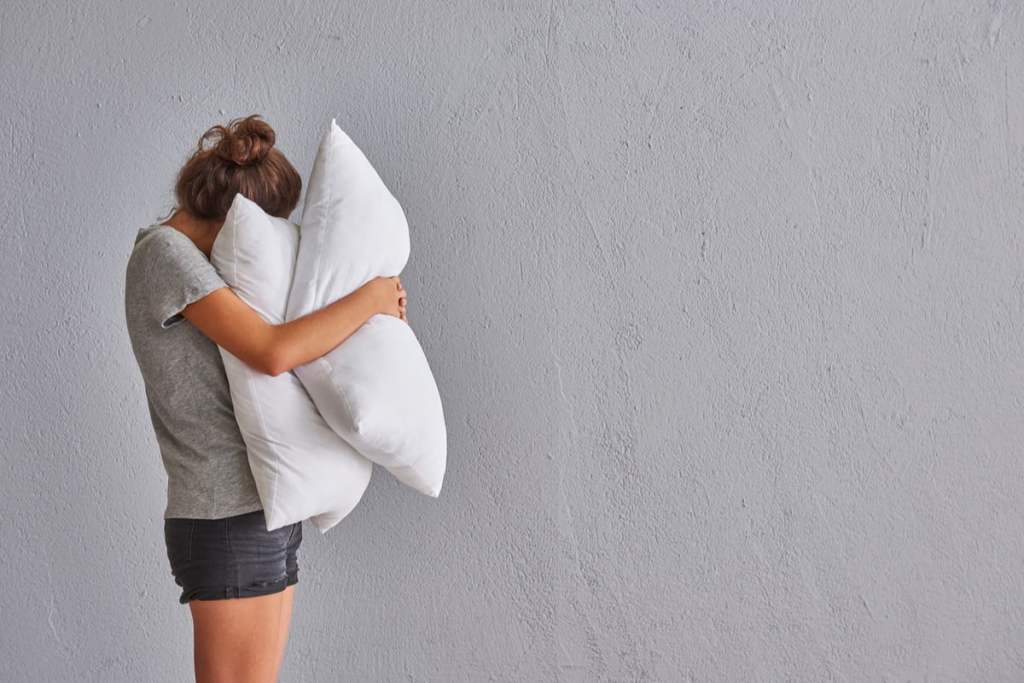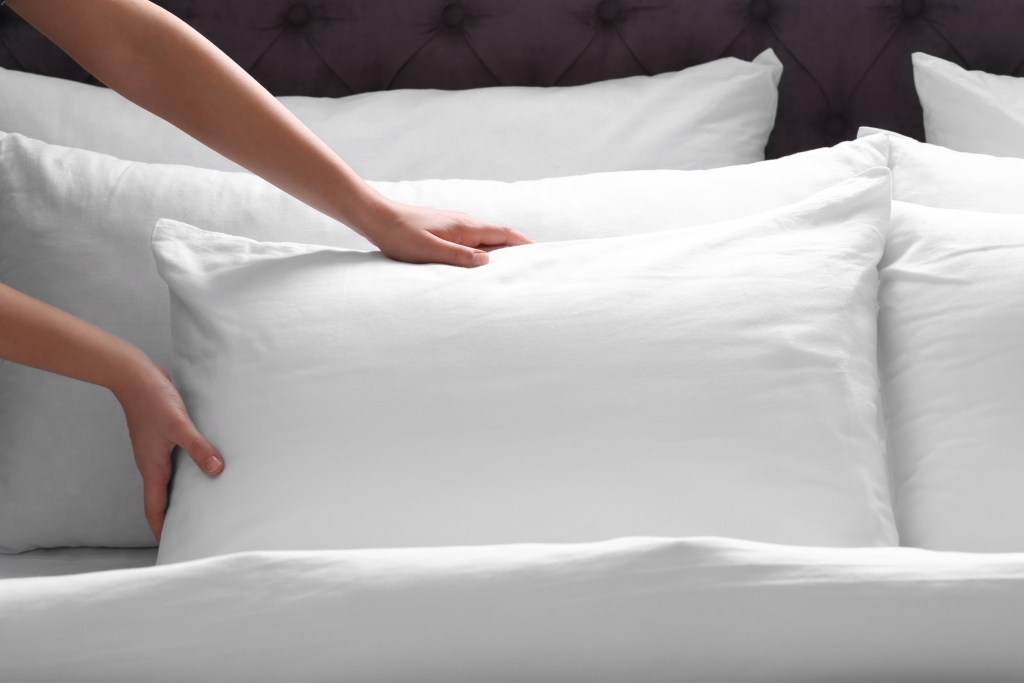Are you thinking about throwing out your old pillows in favor of new, more comfortable ones with the best pillow filling for you? After all, you just want something more fitting, something better for your neck and back overall. But you have to consider many factors when choosing the perfect pillow.
You may have thought about Pillow Cubes as a side sleeper if this has always been your preferred sleeping position, and you’re aware that something too soft would otherwise result in an aggravating stiff neck. If you’re a stomach sleeper, you may have tried sleeping without pillows; and then quickly realized that it only puts stress on your neck and back. Maybe you’ve studied the benefits of knee pillows if you have chronic back pain.
If you wake up with headaches or neck or back pain or still feeling tired, you know as well as anyone that pillows are not one size fits all. Choosing the right pillow that perfectly suits your needs and preferences is important. Loft isn’t the only factor that you should consider when buying a new pillow, though. The material used to stuff the pillow should be just as important as loft and shape.
In fact, a 2014 National Institutes of Health article studied just that and found that pillow stuffing plays a critical role in the quality of sleep. But with so many types of materials used to make pillows, how do you know which is right for you? Let’s talk about the best pillow filling for your sleep needs.

Down pillows
Down is the soft feathers under a bird’s top layer of feathers, and it’s the classic pillow filling. Down is incredibly soft and fluffy and makes you feel like you’re sleeping on a cloud. Though it’s the first material one typically thinks of when they think of pillow filling, down isn’t right for everyone. Down is typically best for back and stomach sleepers who need a pillow that’s soft and keeps their spine in proper alignment. It’s not so great, however, for side sleepers who need a bit more loft and firmness. Let’s break it … down.
Pros of down filling
- Offers unmatched softness. Down is one of the most comfortable materials out there, which is why it’s so popular in mattresses, pillows, and coats.
- Natural and safe. Down is typically made without chemicals. Just make sure the pillow you’re looking to buy is organic and chemical-free beforehand.
- Long-lasting. Take care of your down pillow and it’ll take care of you. With proper TLC, down pillows can last around 15 years.
Cons of down filling
- Pricey. Down pillows are expensive when compared with some other manufactured options.
- Too soft? For side sleepers, the softness might be comfortable at first, but you may wake up sore or with one side of your neck pinched. You should look for a pillow with a firmer material and higher loft.
- It’s an animal product. If you’re a vegan-conscious buyer, down is probably not right for you.
- Requires fluffing. Down pillows can go flat over time, and sometimes need to be re-fluffed. On the upside, fluffing up a down pillow is a great stress reliever.
- Difficult to clean. Throwing your down pillow into your home washing machine is a quick way to ruin it.
- Sleeps hot. Down doesn’t offer the air circulation that some other materials offer, so hot sleepers may find themselves getting too warm at night.

Feather pillows
The first question most people have when researching feather pillows: What’s the difference between feather and down? The answer is anatomy: down is the softer layer underneath the top one, and feather is the material made from the wing and back feathers of the bird. It may not seem like it, but that is a key distinction. Unfortunately (for your wallet), most experts suggest that feather pillows are better in theory than in practice, and recommend dropping the extra money on down pillows rather than trying to save on feather.
Pros of feather filling
- Less expensive. If you like the natural benefits of down pillows but are turned off by the price, take a look at feather pillows.
- Firmer than down. Like the softness of down but want something firmer? Feather is the firmer, top layer of feathers on the bird, so feather pillows will offer firmness that down pillows lack.
Cons of feather filling
- Is something poking me? Unlike down, feather has quills in it, and it’s not uncommon for individual feathers to start poking out of the pillows and into you. Most people prefer not to be awakened by tickling and scratching at their necks in the middle of the night.
- It’s not long-lasting. Feather doesn’t hold up quite like down, so you won’t get as many years out of it — even with proper TLC. That means that in the long run, you may be spending more on feather pillows than you would have if you had you originally purchased a down pillow.
- Not machine wash friendly. Feather pillows are similar to down pillows in the sense that they’re difficult to clean, and you can’t toss them in your home washing machine.
- Sleeps hot. Again, similar to down pillows, feather pillows are not breathable and may make you warm as you sleep.

Latex pillows
Latex makes a great filling for pillows for a variety of reasons, but perhaps one of the best reasons is that they account for less waking pain than other materials. Latex is springy but firm, and it’s great for side sleepers because it stays firm, even for the heaviest and broad-shouldered sleeper.
Pros of latex filling
- Retains its shape. Side sleepers who often find themselves folding their pillow in half won’t need to with latex pillows. Latex pillows often have a high loft, and you don’t have to worry about it collapsing in when you lay down.
- Unmatched firmness. Stomach and back sleepers beware, but these pillows are firm while still conforming to the head and neck. If you’re a stomach or back sleeper who loves the feel of latex pillows, make sure you get one with a very low loft.
- Reduce neck and back stiffness and pain. While we all love to feel cradled in bed, our hunter-gatherer ancestors had it right: the firmer and harder the material we sleep on, the better for our body. Luckily, latex doesn’t feel quite as hard as the ground our ancestors slept on, but the best latex pillows are great for relieving neck and back pain from sleeping.
- It sleeps cool. Latex doesn’t hold heat, so you’ll feel like you’re sleeping on the cool side of the pillow all night. Sleepers who get hot at night will love sleeping on latex.
Cons of latex filling
- It can be too firm for some sleepers. Latex is firm but springy, making it very comfortable for many sleepers. For sleepers who want to sink into their pillow, latex will be too hard.
- What’s that smell? It might be your latex pillow. Latex may have a chemical smell when you first take it out of the box, so you’ll need to let it air out for a few days. However, the smell will go away — just be patient.
- It’s a common allergen. Latex is a fairly common allergen. If you’ve experienced adverse reactions to latex in the past, skip this pillow. Anaphylactic shock doesn’t mix well with good sleep.

Memory foam pillows
The benefits of memory foam are notable and numerous, and so much so that it has completely changed the pillow game. When we think of memory foam, we think of that perfectly manicured hand pressing into the mattress, then the mattress slowly bouncing back to its original shape. Or, maybe, a person jumping on a clean, white mattress with a glass of wine standing upright, unmoving, on the other side. While these examples are hyperbolic (who leaves a glass of red wine on a mattress? I mean, honestly?), memory foam is a pretty wonderful material for mattresses and pillows alike.
Pros of memory foam
- Perfect mix of softness and firmness. Memory foam will form to your head and neck, but it won’t lose its shape.
- Can relieve snoring. Because memory foam keeps the head and neck in line with the spine, it keeps the airway open and curbs snoring.
- Hypoallergenic. If you love latex but have a latex allergy, memory foam may be a great alternative.
- Retains shape. You might find yourself sinking through the pillow as the night goes on – not memory foam.
Cons of memory foam
- Lacks breathability. Memory foam can sleep hot because it doesn’t offer good air circulation. Hot sleepers should keep this in mind when looking at memory foam pillows. However, if you’re set on memory foam but sleep hot, there are options that cater to you.
- Smelly. Like latex, fresh-from-the-box memory foam can smell like chemicals and needs to air out for a few days. You don’t want to put your head down on a pillow that smells, do you?
- Expensive. Memory foam is more expensive than some other options, though there are some great choices for sleepers on a budget, too.
- Heavy. Memory foam can be quite heavy, and when you’re half asleep at 3 a.m. trying to adjust the pillow, that can get annoying.

Polyester fiberfill pillows
Polyester fiberfill is also known by the branded name Poly-Fil. You’re likely familiar with polyester fiberfill because it’s commonly used in dolls, stuffed animals, and crafts. You’ll need to ask yourself — do you want to feel like you’re sleeping on one of your childhood toys? The answer for some of us likely is … maybe so.
Pros of polyester fiberfill
- Cheapest out there. Polyester fiberfill is one of the cheapest materials you can get in a pillow. In fact, you can pick up a 32-ounce bag of Poly-Fil from your local JoAnn Fabric.
- Very light.
- Yes, you can throw it in the wash. If you’re looking for an easy pillow to clean and care for, polyester fiberfill pillows are the definitive choice.
Cons of polyester fiberfill
- It feels cheap. Polyester fiberfill is cheap and feels that way, too.
- Clumpy. Polyester fiberfill clumps together, and you may feel like there are knots bunching up inside of your pillow, which can cause neck pain if you don’t re-fluff and readjust the pillow.
- Short lifespan. This material is not high quality, and its lifespan is evidence of that.
- Sleeps hot.
- Made with chemicals. Because polyester fiberfill is made with a lot of different chemicals, you’ll have to ensure during the buying process that your polyester fiberfill pillow is safe to sleep on every night. The last thing you want to do is breathe in harmful chemicals for eight hours every night.

Buckwheat hull pillows
If you’re unfamiliar with this type of pillow, it might sound strange at first, but buckwheat hull is a popular fill material for pillows, and for good reason. This material is made by removing the shell of the buckwheat seed. In order to make it safe to use for pillows, the buckwheat hull is cleaned and debris is removed. These pillows are great for side sleepers and back sleepers, but they’re typically too firm for stomach sleepers who don’t want to sleep without a pillow.
Pros of buckwheat hull pillows
- Highly supportive. Buckwheat hull is soft, but it’s still derived from a seed, so it’s firm and supportive to keep your spine in alignment and relieve waking pain.
- Sleeps cool. It makes sense: buckwheat hull doesn’t retain heat and is highly breathable, so hot sleepers will benefit from one of the best cooling pillows available.
- Long-lasting.
- Adjustable loft. Buckwheat hull is more customizable and adjustable than any other pillow. If it’s too firm, you can simply remove some of the buckwheat hulls. If it’s too soft, buckwheat hull is easily bought on Amazon and through other retailers, so stuff it up to your liking.
- Natural. It’s made from a seed, so you don’t really get more sustainable or natural than that.
Cons of buckwheat hull pillows
- Expensive. Buckwheat hull can be pricey, but you can rest easy knowing you’re buying a quality pillow.
- Buckwheat hull is noisy. Being derived from a seed, buckwheat hull pillows can make a quiet swishing or rustling noise when you move or adjust the pillow at night.
- Heavy. The weight of buckwheat hull pillows depends on how firm and dense you prefer your pillows, but even the thinnest buckwheat pillows are hefty.

Microbead fiber pillows
Microbeads are controversial, and deservedly so. A few years ago, you likely saw microbeads in all sorts of bathroom products, such as your hand soap, body wash, and face wash. It was like glitter; it was all over the place. The microbeads were not biodegradable, so the Microbead-Free Waters Act of 2015 put an end to their use in rinse-off products at a federal level, though some states allow biodegradable microbeads. However, you still find microbeads in pillows, bean bags, and toys, and the material is accepted for the level of comfort it provides.
Pros of microbead fiber pillows
- Conform to the head and neck. These pillows are comfortable because they’ll shape to your body.
- Sleep cool. As with some of the best cooling pillows that use a bunch of one small material, microbead pillows offer a high level of breathability and keep you cool at night.
- Lightweight. Microbead pillows are great for travel. Many travel pillows use microbeads for this reason.
Cons of microbead fiber pillows
- Can be lumpy. Beads can get clumped up, and you may find yourself grabbing the pillow and shaking it wildly in the middle of the night to redistribute the beads in the pillow.
- Some are not eco-friendly. Microbeads have a bad rap because they’re tiny pieces of plastic. Some microbeads are not biodegradable, which means parts of your pillow may outlive even you. Ensure your microbead fiber pillow is stuffed with biodegradable microbeads.
- Smelly. Microbead fiber pillows have a degree of off-gassing at first. Throw it on the patio for a few days before use.
- Short lifespan. Microbeads flatten out with a lot of use, so you may soon find yourself sleeping on a flat sheet of plastic circles.

Kapok pillows
Derived from the lush Kapok trees native to Mexico, Kapok pillow stuffing offers a unique blend of natural comfort and sustainability. Also known as Ceiba Pentandra, these fluffy, cotton-like fibers make an excellent choice for eco-conscious sleepers, especially those with allergies seeking a 100% organic option.
Pros of Kapok pillows
- Natural. These pillows are entirely free from harmful materials.
- Eco-friendly. Kapok is a renewable resource, making it environmentally responsible.
- Feather-light comfort. Experience a plush, lightweight embrace for a restful night’s sleep.
Cons of Kapok pillows
- Not as moldable. Unlike foam or down pillows, Kapok pillows are less moldable.
- Limited availability. Sourcing Kapok pillows may pose challenges in some regions.
- Flammability. Kapok is flammable, so exercise caution near open flames.
After finally picking the perfect one that suits and supports your preferred sleeping position and needs, it’s important to keep your pillows clean, fresh, and fluffy so you can have the best quality sleep.




